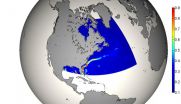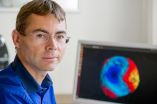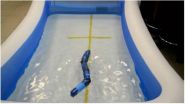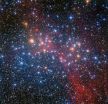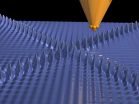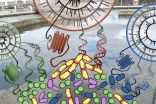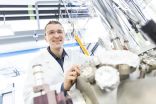(Press-News.org) This news release is available in German.
Just four months after the final data package from the GOCE satellite mission was delivered, researchers are laying out a rich harvest of scientific results, with the promise of more to come. A mission of the European Space Agency (ESA), the Gravity Field and Steady-State Ocean Circulation Explorer (GOCE) provided the most accurate measurements yet of Earth's gravitational field. The GOCE Gravity Consortium, coordinated by the Technische Universität München (TUM), produced all of the mission's data products including the fifth and final GOCE gravity model. On this basis, studies in geophysics, geology, ocean circulation, climate change, and civil engineering are sharpening the picture of our dynamic planet - as can be seen in the program of the 5th International GOCE User Workshop, taking place Nov. 25-28 in Paris.
The GOCE satellite made 27,000 orbits between its launch in March 2009 and re-entry in November 2013, measuring tiny variations in the gravitational field that correspond to uneven distributions of mass in Earth's oceans, continents, and deep interior. Some 800 million observations went into the computation of the final model, which is composed of more than 75,000 parameters representing the global gravitational field with a spatial resolution of around 70 kilometers. The precision of the model improved over time, as each release incorporated more data. Centimeter accuracy has now been achieved for variations of the geoid - a gravity-derived figure of Earth's surface that serves as a global reference for sea level and heights - in a model based solely on GOCE data.
The fifth and last data release benefited from two special phases of observation. After its first three years of operation, the satellite's orbit was lowered from 255 to 225 kilometers, increasing the sensitivity of gravity measurements to reveal even more detailed structures of the gravity field. And through most of the satellite's final plunge through the atmosphere, some instruments continued to report measurements that have sparked intense interest far beyond the "gravity community" - for example, among researchers concerned with aerospace engineering, atmospheric sciences, and space debris.
Moving on: new science, future missions
Through the lens of Earth's gravitational field, scientists can image our planet in a way that is complementary to approaches that rely on light, magnetism, or seismic waves. They can determine the speed of ocean currents from space, monitor rising sea level and melting ice sheets, uncover hidden features of continental geology, even peer into the convection machine that drives plate tectonics. Topics like these dominate the more than 100 talks scheduled for the 5th GOCE User Workshop, with technical talks on measurements and models playing a smaller role. "I see this as a sign of success, that the emphasis has shifted decisively to the user community," says Prof. Roland Pail, director of the Institute for Astronomical and Physical Geodesy at TUM.
This shift can be seen as well among the topics covered by TUM researchers, such as estimates of the elastic thickness of the continents from GOCE gravity models, mass trends in Antarctica from global gravity fields, and a scientific roadmap toward worldwide unification of height systems. For his part Pail - who was responsible for delivery of the data products - chose to speak about consolidating science requirements for a next-generation gravity field mission.
INFORMATION:
TUM has organized a public symposium on "Seeing Earth in the 'light' of gravity" for the 2015 Annual Meeting of the American Association for the Advancement of Science in San Jose, California. This session, featuring speakers from Australia, Canada, Denmark, France, Germany and Italy, takes place on Feb. 14, 2015. (See http://meetings.aaas.org/.)
This research was supported in part by the European Space Agency.
Publication:
"EGM_TIM_RL05: An Independent Geoid with Centimeter Accuracy Purely Based on the GOCE Mission," Jan Martin Brockmann, Norbert Zehentner, Eduard Höck, Roland Pail, Ina Loth, Torsten Mayer-Gürr, and Wolf-Dieter Shuh. Geophysical Research Letters 2014, doi:10.1002/2014GL061904.
Contact:
Prof. Roland Pail
Institute for Astronomical and Physical Geodesy
Technische Universität München
Tel: +49 89 289 23190
roland.pail@tum.de
Further information:
http://www.iapg.bgu.tum.de/iapg_en.html
http://www.goce2014.org/
Technische Universität München (TUM) is one of Europe's leading research universities, with around 500 professors, 10,000 academic and non-academic staff, and 36,000 students. Its focus areas are the engineering sciences, natural sciences, life sciences and medicine, reinforced by schools of management and education. TUM acts as an entrepreneurial university that promotes talents and creates value for society. In that it profits from having strong partners in science and industry. It is represented worldwide with a campus in Singapore as well as offices in Beijing, Brussels, Cairo, Mumbai, and São Paulo. Nobel Prize winners and inventors such as Rudolf Diesel and Carl von Linde have done research at TUM. In 2006 and 2012 it won recognition as a German "Excellence University." In international rankings, it regularly places among the best universities in Germany.
http://www.tum.de
The value of a piece of chocolate cake can change. Someone who happens to be on a diet is more likely to choose a fruit dessert and judge the calorie-laden cake as unhealthy. Previous studies have shown that a specific network in the brain is active when a person must decide between various choices that vary depending on context. They emphasize the interaction between neurons in two brain areas of the prefrontal cortex - the controlling area on the front side of the brain.
Prefrontal cortex shows increased activity in all decisions
Sarah Rudorf and Todd Hare of the ...
On 24 October 2014, Sweden called off the hunt for a submarine after a week-long underwater search in the Stockholm archipelago. Triggered by a reported sighting of a Russian submarine, the alleged 'invasion' had been widely anticipated by military specialists and the media.
"Our assessment is that in the inner archipelago there was a plausible foreign underwater operation," Rear Adm. Anders Grenstad commented, "But we believe that what has violated Swedish waters has left."
"Whatever was there could not have been a conventional submarine," Grenstad said, but a "craft ...
This news release is available in Japanese.
The deep ocean seems so remote that it is difficult to imagine any sort of human-generated change making an impact on deep-sea life. It is even more difficult to collect or examine evidence from the deep ocean to determine what those impacts might be. Enter the barnacle; a hard, sessile creature that looks like a tiny volcano and attaches to rocks, boat bottoms, and other hard substrates, where it filters ocean water to feed on tiny organisms. The barnacle holds clues about how climate change is affecting the deep ocean. ...
KNOXVILLE - Warfare not only hastened human technological progress and vast social and political changes, but may have greatly contributed to the evolutionary emergence of humans' high intelligence and ability to work together toward common goals, according to a new study from the National Institute for Mathematical and Biological Synthesis (NIMBioS).
How humans evolved high intelligence, required for complex collaborative activities, despite the various costs of having a big brain has long puzzled evolutionary biologists. While the human brain represents only about two ...
Published in the journal Nature, the discovery could revolutionise fuel cells and other hydrogen-based technologies as they require a barrier that only allow protons - hydrogen atoms stripped off their electrons - to pass through.
In addition, graphene membranes could be used to sieve hydrogen gas out of the atmosphere, where it is present in minute quantities, creating the possibility of electric generators powered by air.
One-atom thick material graphene, first isolated and explored in 2004 by a team at The University of Manchester, is renowned for its barrier properties, ...
NGC 3532 is a bright open cluster located some 1300 light-years away in the constellation of Carina(The Keel of the ship Argo). It is informally known as the Wishing Well Cluster, as it resembles scattered silver coins which have been dropped into a well. It is also referred to as the Football Cluster, although how appropriate this is depends on which side of the Atlantic you live. It acquired the name because of its oval shape, which citizens of rugby-playing nations might see as resembling a rugby ball.
This very bright star cluster is easily seen with the naked eye ...
Jülich, 26 November 2014 - In metals such as copper or aluminium, so-called conduction electrons are able to move around freely, in the same way as particles in a gas or a liquid. If, however, impurities are implanted into the metal's crystal lattice, the electrons cluster together in a uniform pattern around the point of interference, resembling the ripples that occur when a stone is thrown into a pool of water. Scientists in Jülich have, with the help of computer simulations, now discovered a combination of materials that strengthens these Friedel oscillations ...
The Luxembourg Centre for Systems Biomedicine (LCSB) has succeeded for the first time in describing the complex relationships within an ecosystem in unprecedented detail. For their work, carried out in collaboration with US and Luxembourg partners, their model ecosystem was a "biological wastewater treatment plant". In it live numerous species of bacteria which are involved in the wastewater purification process.
LCSB director Prof. Dr. Rudi Balling stresses the medical importance of these research efforts: "Bacterial ecosystems also play a major role in our health. ...
Although the van der Waals force was discovered around 150 years ago, it is still difficult to quantify when predicting the behaviour of solids, liquids, and molecules. Precise measurements were only possible up to now for single atoms or macroscopic objects. However, the van der Waals forces are particularly important at intermediate size, where they crucially co-determine the behaviour of complex molecules, such as biomolecules and proteins. They are also responsible for the functioning of certain adhesives and are the reason why geckos can adhere so amazingly well to ...
This news release is available in French. The way people with autism spectrum disorder (ASD) gather information - not the judgement process itself - might explain why they gain different perceptions from peoples' faces, according to a new study from Hôpital Rivière-des-Prairies and the University of Montreal. "The evaluation of an individual's face is a rapid process that influences our future relationship with the individual," said Baudouin Forgeot d'Arc, lead author of the study. "By studying these judgments, we wanted to better understand how people with ...
